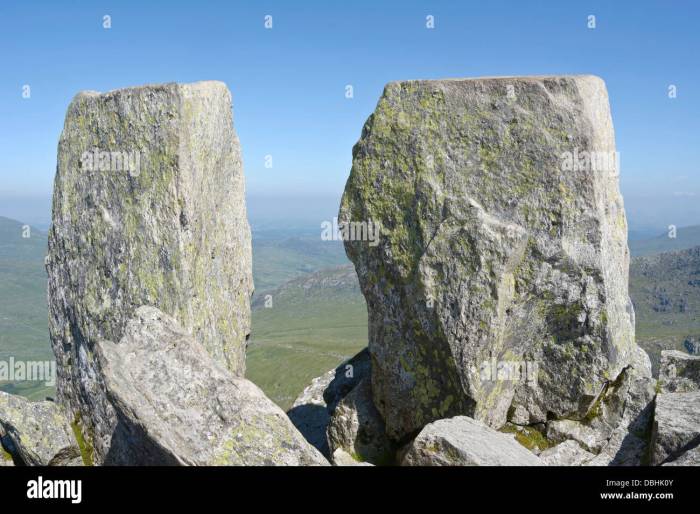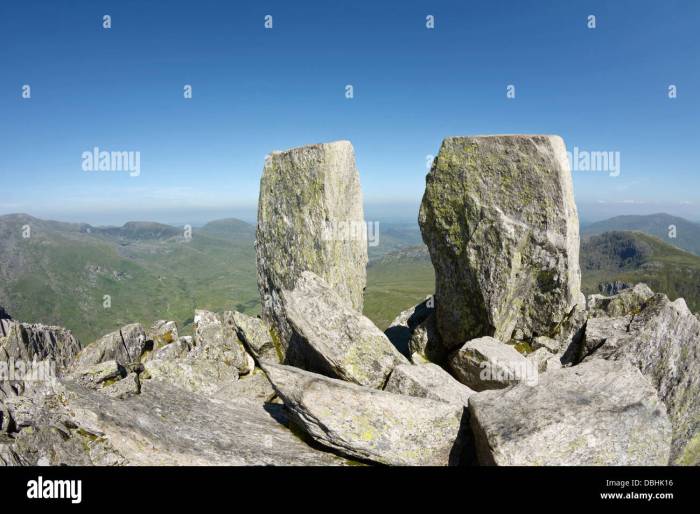The Pillars of Adam and Eve, an enigmatic geological formation, stand as a testament to the forces that have shaped our planet. These towering pillars, steeped in historical and religious significance, beckon us to explore their captivating narrative, unraveling the secrets of their formation and the diverse ecosystem that surrounds them.
Carved by the relentless forces of erosion over eons, these pillars have become a symbol of the enduring power of nature. Their unique composition and structure offer insights into the geological processes that have shaped our planet, while the flora and fauna that inhabit their surroundings showcase the delicate balance of life in this rugged landscape.
Historical and Religious Significance

The Pillars of Adam and Eve are two monolithic rock formations located in the Tabuk region of Saudi Arabia. They hold great significance in both religious and historical contexts.
Biblical Narrative
According to the biblical narrative, the Pillars of Adam and Eve are believed to be the remains of the petrified bodies of Adam and Eve, the first man and woman created by God. It is said that after they were banished from the Garden of Eden for eating the forbidden fruit, they wandered the earth and eventually settled in the Tabuk region.
Upon their death, their bodies turned into stone, forming the pillars that stand today.
Cultural and Religious Interpretations
The Pillars of Adam and Eve have been the subject of various cultural and religious interpretations throughout history. Some local tribes believe that the pillars possess supernatural powers and offer prayers and sacrifices at their base. Others consider them to be symbols of fertility and hope, and visit them for blessings and healing.
Geographical Location and Description

The Pillars of Adam and Eve are two colossal rock formations located in the Arabian Desert, approximately 22 kilometers southwest of Tabuk in northwestern Saudi Arabia. These pillars are part of a larger sandstone formation known as the Tabuk Formation, which dates back to the Cretaceous period.
The Pillars of Adam and Eve are distinct geological landmarks that have captivated the imagination of travelers and explorers for centuries. They rise prominently from the surrounding desert landscape, forming an iconic feature of the region. The taller of the two pillars, known as the Pillar of Adam, stands at an impressive height of approximately 50 meters, while the shorter pillar, the Pillar of Eve, is about 30 meters tall.
Geological Formation
The Pillars of Adam and Eve are composed of sandstone, a sedimentary rock formed from the accumulation and compaction of sand grains over time. The sandstone in this region is characterized by its reddish-brown color and distinctive layering. The pillars have been shaped by centuries of erosion, primarily due to wind and water, resulting in their current slender and pointed appearance.
Surrounding Environment
The Pillars of Adam and Eve are situated in a desolate and rugged desert environment. The surrounding landscape is characterized by rolling sand dunes, scattered vegetation, and occasional rocky outcrops. The area is home to a variety of desert wildlife, including lizards, snakes, and birds of prey.
Geological Formation and Composition: Pillars Of Adam And Eve
The Pillars of Adam and Eve stand as remnants of a once-vast sandstone formation that eroded over time. The geological processes that shaped these pillars are complex and fascinating.
The sandstone that forms the pillars was deposited during the Triassic period, around 250 million years ago. Over time, this sandstone was uplifted and exposed to the elements. Wind, rain, and freezing temperatures gradually eroded the softer parts of the rock, leaving behind the harder, more resistant pillars.
Mineral Composition and Structure
The Pillars of Adam and Eve are composed primarily of sandstone, a sedimentary rock made up of sand-sized grains of quartz and feldspar. The sandstone is cemented together by a matrix of calcite, a mineral composed of calcium carbonate.
The sandstone that forms the pillars is relatively porous, meaning it contains small spaces between the grains of sand. These pores allow water to seep into the rock, which can cause the rock to weaken and erode over time.
Erosion and Weathering Patterns

The Pillars of Adam and Eve have been subjected to various weathering processes over time, shaping their distinctive morphology and impacting their stability.
The weathering processes that have played a significant role in shaping the pillars include physical weathering, chemical weathering, and biological weathering.
Physical Weathering
- Freeze-thaw weathering:Water seeping into cracks and crevices of the sandstone freezes and expands, causing the rock to fracture and break down.
- Exfoliation:The outer layers of the sandstone peel away due to temperature changes and the expansion and contraction of minerals.
- Wind erosion:Wind-blown sand and dust abrade the sandstone surface, creating smooth and polished areas.
Chemical Weathering, Pillars of adam and eve
- Carbonation:Carbon dioxide in the atmosphere reacts with water to form carbonic acid, which dissolves the calcium carbonate in the sandstone.
- Oxidation:Iron-bearing minerals in the sandstone react with oxygen to form iron oxides, which give the pillars their characteristic red-brown color.
Biological Weathering
- Plant roots:Roots of plants growing in cracks and crevices exert pressure, causing the rock to fracture and break down.
- Lichen:Lichens secrete acids that dissolve minerals in the sandstone, contributing to its erosion.
The combined effects of these weathering processes have created the intricate shapes and textures of the Pillars of Adam and Eve. Erosion has played a crucial role in their ongoing evolution, gradually altering their morphology and potentially affecting their stability in the long term.
The Pillars of Adam and Eve, a prominent landmark in Saudi Arabia, stand tall as a testament to the region’s rich geological history. For a deeper understanding of the geological processes that shaped these pillars, be sure to check out unit 4 session 3 letrs . This informative resource provides insights into the formation of sedimentary rocks and the role of erosion in shaping the Pillars of Adam and Eve.
Flora and Fauna Associated with the Pillars

The Pillars of Adam and Eve are home to a diverse array of plant and animal life. The surrounding area is characterized by a Mediterranean climate, with hot, dry summers and mild, wet winters. This climate supports a wide range of vegetation, including evergreen forests, shrublands, and grasslands.The
plant life associated with the pillars plays a crucial role in the ecosystem. The trees and shrubs provide shade and shelter for animals, while the grasses and wildflowers provide food and cover. The plants also help to stabilize the soil and prevent erosion.The
animal life associated with the pillars is equally diverse. The area is home to a variety of mammals, birds, reptiles, and amphibians. The mammals include wild boar, foxes, rabbits, and hedgehogs. The birds include eagles, hawks, owls, and songbirds. The reptiles include snakes, lizards, and turtles.
The amphibians include frogs, toads, and salamanders.The animals that live in the area surrounding the pillars play an important role in the ecosystem. They help to control the populations of plants and animals, and they also contribute to the decomposition of organic matter.
Ecological Significance
The flora and fauna associated with the Pillars of Adam and Eve are essential to the ecological balance of the area. The plants provide food, shelter, and nesting sites for the animals, while the animals help to control the populations of plants and disperse their seeds.
The interaction between the plants and animals creates a complex and dynamic ecosystem that is home to a wide variety of species.The Pillars of Adam and Eve are a unique and beautiful natural wonder. The area is home to a diverse array of plant and animal life, and it is an important part of the local ecosystem.
The pillars are a popular destination for tourists and nature enthusiasts, and they offer a glimpse into the natural beauty of the Mediterranean region.
Tourism and Conservation

The Pillars of Adam and Eve are popular tourist destinations, attracting visitors from around the world. The natural formations offer a unique and awe-inspiring sight, drawing both nature enthusiasts and photographers.
Tourism has brought economic benefits to the surrounding area, supporting local businesses and creating employment opportunities. However, it also poses challenges to the preservation of these fragile natural formations.
Conservation Efforts
Conservation efforts aim to balance tourism with the protection of the Pillars of Adam and Eve. Measures include:
- Limiting the number of visitors allowed at any given time
- Establishing designated trails and viewing platforms
- Educating visitors about the importance of preserving the formations
- Monitoring the impact of tourism on the surrounding environment
By implementing these measures, conservationists hope to ensure that the Pillars of Adam and Eve remain a natural wonder for generations to come.
Clarifying Questions
Where are the Pillars of Adam and Eve located?
The Pillars of Adam and Eve are located in the Makhtesh Ramon Nature Reserve in Israel.
What is the significance of the Pillars of Adam and Eve in religious texts?
In the biblical narrative, the Pillars of Adam and Eve are said to be the petrified remains of Adam and Eve after they were expelled from the Garden of Eden.
How tall are the Pillars of Adam and Eve?
The Pillars of Adam and Eve are approximately 40 meters tall.